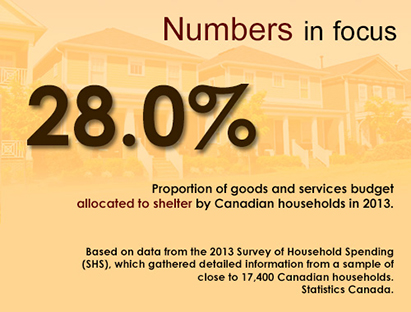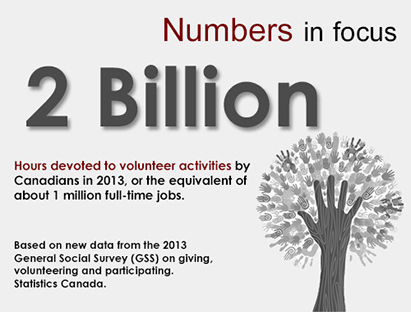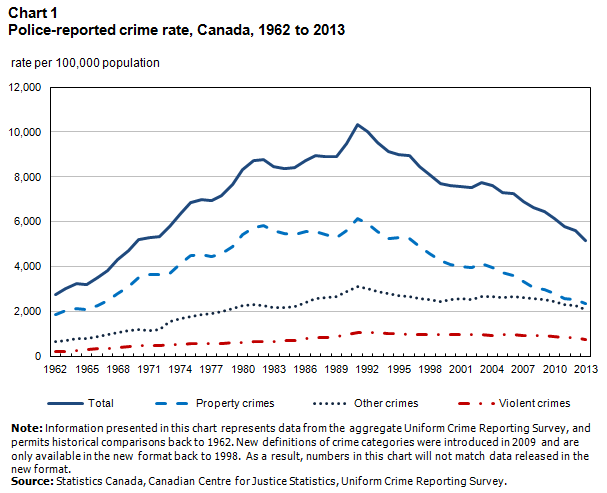The Business & Community Newsletter – March 2015
Archived Content
Information identified as archived is provided for reference, research or recordkeeping purposes. It is not subject to the Government of Canada Web Standards and has not been altered or updated since it was archived. Please "contact us" to request a format other than those available.

Feature articles
Spending on goods and services by Canadian households up 4.1%

Numbers in Focus - 28.0%
Proportion of goods and services budget allocated to shelter by Canadian households in 2013.
Based on data from the 2013 Survey of Household Spending (SHS), which gathered detailed information from a sample of close to 17,400 Canadian households. Statistics Canada.
According to the Survey of Household Spending, 2013, Canadian households spent an average of $58,592 on goods and services in 2013, up 4.1% from 2012.
Spending on shelter accounted for 28.0% of this total, followed by transportation (20.6%) and food (13.6%). These shares were virtually unchanged from 2012.
Provincially, the highest average spending on goods and services was reported by households in Alberta ($71,429), followed by British Columbia ($61,007) and Ontario ($60,718). Households in Prince Edward Island ($47,410) reported the lowest average spending.
On average, couples with children spent $81,636 on goods and services. One-person households headed by a senior aged 65 years and older reported the lowest average spending of all household types at $29,064 in 2013.
Do you volunteer your time or give money to a charitable or non-profit organization?

Numbers in Focus - 2 Billion
Hours devoted to volunteer activities by Canadians in 2013, or the equivalent of about 1 million full-time jobs.
Based on new data from the 2013 General Social Survey (GSS) on giving, volunteering and participating. Statistics Canada.
If you do, you are not alone! According to the General Social Survey: Giving, volunteering and participating, 2013, 44% of Canadians volunteered their time and almost twice as many (82%) gave money to a charitable or non-profit organization that year.
While the proportion of Canadians who volunteered their time declined by 3 percentage points between 2010 and 2013, the total number of hours volunteered remained virtually unchanged.
In 2013, volunteers devoted almost 2 billion hours to their volunteer activities, or the equivalent of about 1 million full-time jobs. Canadians who volunteered did so for an annual average of 154 hours in 2013.
The percentage of Canadians donating to charitable or non-profit organizations declined in recent years, falling from 84% in 2010 to 82% in 2013. Donation amounts, however, increased.
The average annual amount per donor in 2013 was $531, up $61 from 2010. Overall, Canadians gave $12.8 billion to charitable or non-profit organizations in 2013, 14% higher than 2010.
Employer pensions and the wealth of Canadian families
 For most Canadians, the accumulation of private wealth during working years is a requisite for maintaining a comfortable standard of living in retirement. For many Canadians, employer-sponsored registered pension plans (RPPs) have been an important part of this process. Yet changes in the economic landscape over the past several decades have prompted some employers to move away from offering workplace pensions.
For most Canadians, the accumulation of private wealth during working years is a requisite for maintaining a comfortable standard of living in retirement. For many Canadians, employer-sponsored registered pension plans (RPPs) have been an important part of this process. Yet changes in the economic landscape over the past several decades have prompted some employers to move away from offering workplace pensions.
Here is the question: do families who are not covered by RPPs accumulate as much wealth as their counterparts who belong to such plan? Read the "Study: Employer pensions and the wealth of Canadian families, 2012" for the answers and more.
Family violence accounts for over one-quarter of all violent crimes reported to police
 According to a Statistics Canada report titled "Family violence in Canada: A statistical profile, 2013", there were just under 88,000 victims of family violence in Canada in 2013. This represented more than one-quarter of all violent crimes reported to police.
According to a Statistics Canada report titled "Family violence in Canada: A statistical profile, 2013", there were just under 88,000 victims of family violence in Canada in 2013. This represented more than one-quarter of all violent crimes reported to police.
Just under half (48%) of all victims of family violence were victimized by a current or former spouse. For another 17% of family violence victims, the accused was a parent, while for 14% the accused was an extended family member such as an in-law, uncle or grandparent. A further 11% of family violence victims were victimized by a sibling and for 10% the accused was the victim's own child.
A special focus of the 2013 report is intimate partner violence, which refers to violence against current or former spouses or dating partners (whether or not the individuals live together). Of the more than 90,300 victims of police-reported violence by an intimate partner, 53% had been victimized by a dating partner and 47% by a spouse.
For both males and females, intimate partner violence was most likely to occur when individuals were in their twenties and thirties. However, women in their early twenties (20 to 24 years old) experienced the greatest risk of violent victimization by an intimate partner (1,127.7 per 100,000 population).
Overall, the rate of police-reported intimate partner victimization was higher for females than for males, regardless of age, with women accounting for nearly 80% of all intimate partner victims reported to police.
Charges were laid or recommended in the majority of intimate partner violence incidents brought to the attention of police.
Also Worth a Read
Canada's crime rate: Two decades of decline
Statistics Canada's latest "Canadian Magatrends" tells the story of two decades of decline in Canada' overall crime rate. As indicated in Chart 1, the police-reported crime rate in 2013 was at its lowest point since 1969. More information in the article "Canada's crime rate: Two decades of decline".

Description for Chart 1
| Year | Violent crimes | Property crimes | Other crimes | Total |
|---|---|---|---|---|
| rate per 100,000 population | ||||
| 1962 | 221 | 1,891 | 659 | 2,771 |
| 1963 | 249 | 2,047 | 726 | 3,022 |
| 1964 | 284 | 2,146 | 815 | 3,245 |
| 1965 | 299 | 2,091 | 809 | 3,199 |
| 1966 | 347 | 2,258 | 907 | 3,511 |
| 1967 | 381 | 2,484 | 985 | 3,850 |
| 1968 | 423 | 2,826 | 1,087 | 4,336 |
| 1969 | 453 | 3,120 | 1,164 | 4,737 |
| 1970 | 481 | 3,515 | 1,217 | 5,212 |
| 1971 | 492 | 3,649 | 1,170 | 5,311 |
| 1972 | 497 | 3,634 | 1,224 | 5,355 |
| 1973 | 524 | 3,704 | 1,546 | 5,773 |
| 1974 | 553 | 4,151 | 1,684 | 6,388 |
| 1975 | 585 | 4,498 | 1,769 | 6,852 |
| 1976 | 584 | 4,533 | 1,867 | 6,984 |
| 1977 | 572 | 4,466 | 1,933 | 6,971 |
| 1978 | 580 | 4,579 | 1,995 | 7,154 |
| 1979 | 610 | 4,903 | 2,153 | 7,666 |
| 1980 | 636 | 5,444 | 2,263 | 8,343 |
| 1981 | 654 | 5,759 | 2,322 | 8,736 |
| 1982 | 671 | 5,840 | 2,262 | 8,773 |
| 1983 | 679 | 5,608 | 2,182 | 8,470 |
| 1984 | 701 | 5,501 | 2,185 | 8,387 |
| 1985 | 735 | 5,451 | 2,227 | 8,413 |
| 1986 | 785 | 5,550 | 2,392 | 8,727 |
| 1987 | 829 | 5,553 | 2,575 | 8,957 |
| 1988 | 868 | 5,439 | 2,613 | 8,919 |
| 1989 | 911 | 5,289 | 2,692 | 8,892 |
| 1990 | 973 | 5,612 | 2,900 | 9,485 |
| 1991 | 1,059 | 6,160 | 3,122 | 10,342 |
| 1992 | 1,084 | 5,904 | 3,052 | 10,040 |
| 1993 | 1,082 | 5,575 | 2,881 | 9,538 |
| 1994 | 1,047 | 5,257 | 2,821 | 9,125 |
| 1995 | 1,009 | 5,292 | 2,707 | 9,008 |
| 1996 | 1,002 | 5,274 | 2,656 | 8,932 |
| 1997 | 993 | 4,880 | 2,603 | 8,475 |
| 1998 | 995 | 4,569 | 2,529 | 8,093 |
| 1999 | 971 | 4,276 | 2,449 | 7,695 |
| 2000 | 996 | 4,081 | 2,534 | 7,610 |
| 2001 | 995 | 4,004 | 2,593 | 7,592 |
| 2002 | 980 | 3,976 | 2,560 | 7,516 |
| 2003 | 978 | 4,125 | 2,670 | 7,773 |
| 2004 | 957 | 3,976 | 2,668 | 7,601 |
| 2005 | 962 | 3,744 | 2,620 | 7,326 |
| 2006 | 968 | 3,605 | 2,673 | 7,246 |
| 2007 | 952 | 3,335 | 2,621 | 6,908 |
| 2008 | 938 | 3,096 | 2,598 | 6,632 |
| 2009 | 926 | 3,005 | 2,531 | 6,462 |
| 2010 | 907 | 2,802 | 2,451 | 6,160 |
| 2011 | 869 | 2,586 | 2,324 | 5,780 |
| 2012 | 841 | 2,521 | 2,269 | 5,632 |
| 2013 | 766 | 2,342 | 2,082 | 5,191 |
| Note: Information presented in this chart represents data from the aggregate Uniform Crime Reporting Survey, and permits historical comparisons back to 1962. New definitions of crime categories were introduced in 2009 and are only available in the new format back to 1998. As a result, numbers in this chart will not match data released in the new format. Source: Statistics Canada, Canadian Centre for Justice Statistics, Uniform Crime Reporting Survey. |
||||
Do you YouTube?
 When asked this question, people offer a variety of answers from watching funny dog videos to the latest music video to learning how to make a soufflé. Those who watch YouTube videos know that it is all about delivering content, not a two-way communication vehicle of social media like Facebook or Twitter. It offers its audience entertainment, visual instructions and information that satisfy every user needs.
When asked this question, people offer a variety of answers from watching funny dog videos to the latest music video to learning how to make a soufflé. Those who watch YouTube videos know that it is all about delivering content, not a two-way communication vehicle of social media like Facebook or Twitter. It offers its audience entertainment, visual instructions and information that satisfy every user needs.
Did you know that Statistics Canada's YouTube channel has videos that cover a range of topics? There are four broad categories: summary of important findings from the 2011 Census and National Household Survey (NHS); tutorials for businesses and communities; survey participants and general StatCan themes.
Since 2012, when we launched our first video, business owners, community planners and researchers have been able to view ways to find, use and understand data on immigration and ethnocultural diversity or data on Housing, Labour or Education.
Have you ever been selected to participate in one of our surveys? Discover why it is important. Get to know us better by discovering what we are doing nationally and globally. Our videos, Serving Canadians: The Fundamental Principles of Official Statistics, and Around the World and Back open your eyes and ears to how your statistical agency meets its mission: Serving Canada with high-quality statistical information that matters.
In the few minutes it takes to watch one of our videos, you will find out about the type of information we have available. So tune in to our YouTube channel at the Stay Connected Portal on our website or go directly to www.youtube.com/statisticscanada.
To make your StatCan experience a two-way communication, subscribe to our YouTube channel to receive updates and stay informed when something new occurs. Let us know what you think by rating us with the thumbs up or thumbs down icon.
As the saying goes, a picture is worth a thousand words. Our videos engage the viewer with numbers that tell a story.
If you didn't know about our videos before now you can see that Statistics Canada You Tube channel offers something for everyone! So YouTube Statistics Canada.
Stay Connected
Visit the Stay Connected portal on Statistics Canada website
No endorsement of any social media products or services is expressed or implied.
Got a Question or Comment?
Please contact our communications staff in your region:
- Atlantic provinces: Sarah Cassidy, sarah.cassidy@statcan.gc.ca
- Quebec: Mandoline Royer, mandoline.royer@statcan.gc.ca
- Ontario: André Langdon, andre.langdon@statcan.gc.ca
- Prairie provinces, British Columbia, Yukon, Northwest Territories and Nunavut: Ashok Mathur, ashok.mathur@statcan.gc.ca.
About the Newsletter
Businesses, municipalities and community organizations have specific information needs. Statistics Canada's Outreach Program is dedicated to serving you with this free newsletter, as well as with ongoing learning and sharing activities.
Help us spread the word
If you know an organization that may benefit from what this newsletter has to offer, please pass it on or put them in contact with us. Please also feel free to share it on your website or other social media platforms.
Newsletter copyright
Use of this publication is governed by the Statistics Canada Open Licence Agreement.
Ce bulletin est aussi disponible en français.
- Date modified:
